ECOLM - An Electronic Corpus of Lute Music
Full TabCode - lines
There are four types of ‘line’ that commonly appear in historical tablatures:
- ‘connecting’ straight lines, which may be vertical, horizontal or sloping, but of which each end can be associated with a tablature chord or a vertical position on the staff relative to a chord;
- ‘connecting’ curved lines, of which each end can be associated with a tablature chord or a vertical position on the staff relative to a chord;
- ‘ensemble’ [French for ‘together’] lines, vertical, visually joining two members of the same chord between which there’s an intervening string without a letter (it means the notes are to be played exactly together, not spread at all);
- ‘separée’ [French for ‘separated’] lines, oblique (either right-end-up or, less commonly, left-end-up), between members of a chord (meaning the chord is to be broken rhythmically)
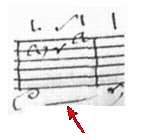
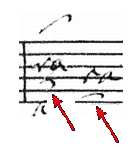

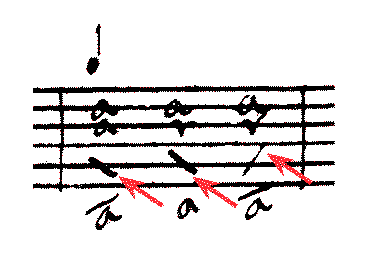
For types a and b, positions relative to the starting and ending letters are given by number, as in this diagram:
1 2 3
4 a 5
6 7 8
(So ‘8’ means the position to the bottom right, or ‘south-east’, of the letter, and so on.)
If a line begins on the staff more than a line-space from the nearest letter, you can use a ‘-’
to indicate a ‘null-letter’ on a certain line as ‘anchor’ to the
line. E.g. ‘Qa1-5’ indicates a normal Qa1 chord, but the ‘-5’
specifies that the line (not yet specified here) will start at a position relative to
the place where a letter would go on the 5th string.
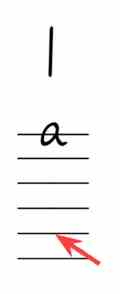
"-5" means attach to this point
Lines (a and b) must be specified by a unique number. The same line-number cannot be used more than once in a piece. (This will be a pain, but seems inevitable.) This is positive for line-beginnings, negative for their corresponding endings. Both line-beginnings and line-endings must be encoded.
There is an exception in the case of simple slurred pairs of notes, where the line-number may be omitted and the line-end need not be encoded. The line is assumed to be a downward-bowing slur starting under this letter and ending under the following letter on the same string in the ‘normal’ position for a slur. The direction of the bow can be made explicit by adding ‘d’ (for downward - the default) or ‘u’ for upward.
The line code, in parentheses, follows the relevant letter/string combination immediately (before the next chord-member). The first item must be one of:
‘C’ (type a or b connecting lines, curved or straight);
‘E’ (type c ‘ensemble’ lines);
‘S’ (type d ‘separée’ lines).
In the case of type a or b lines, the line-number and a colon ‘:’ follow immediately after ‘C’. Then comes a code representing the type of line. For our purposes this can be simplified to ‘<pos>’ (the position-code alone) for straight line starting positions; ‘6<pos>’ for downward-curved (slur-like) line starting position; ‘-6<pos>’ for upward-curved ditto; and just ‘<pos>’ for straight or curved line ending positions.
Straight line example:
Qa1c2d3(C34:8) .... Sd1(C-34:6)a6(here line number 34 begins to the bottom right of the d on line 3 of the first chord and ends [note the minus sign] at the bottom left of the d on the first string of the second chord)
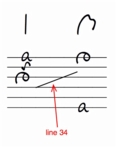
Curved line example:
Qa1c2d3(C34:-63) ... Sd1(C-34:4)a6(here line 34 begins to the top right of d3, and curving/bowing upward [note the minus sign and the ‘6’] ends to the left middle of d1 in the next chord
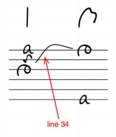
Curved line example 2:
Qa1c2d3-5(C34:68) ... Sd1a6(C-34:6)(here line 34 begins to the bottom right of ‘-5’ [ie where a letter would stand on line 5], and curving/bowing downward [note the ‘6’] ends to the left bottom of a6 in the next chord

Simple slurred pair example:
Sd3(C) c3(here there is a slur between d3 and the following c3, in the ‘normal’ position)

More complex slurred pair example:
Sc2d3(Cu) a3 Ea2c3c4
(here there is an downward-bowed slur between the d3 of the first chord and the next note on that string, a3; the third chord is not part of the slur)

For type c ‘ensemble’ lines the ‘E’ can be followed by a number giving the length of the line, but this may be omitted; the default is for the line to go from position ‘7’ of the top letter to position ‘2’ of the bottom letter.
N.B. There must be at least one empty staff line between the two letters.
(e.g.
Qa1(E)d5means notes a1 and d5 joined by a default ensemble line.
(NB
Qa1(E)c2is illegal - doesn’t happen, because there’s no space!)
For type d ‘separée’ lines, after the ‘S’ comes either
‘u’ to indicate the right end is up, or ‘d’ to indicate
it’s down; but by default, we assume ‘u’ (more common), so all
that is needed usually is ‘S’ alone.
Normally the separée lines are horizontally centred on the letters, but
sometimes they appear to one side of them; in such cases, end with ":l"
(for ‘left), or ":r" (’right’).
A shortcut for the default ‘separée’ line equivalent to
(S) is /
Example 1.
Qa1(S)b3(S)a4(S)Xdis a four-note chord with three separating ‘upward’ slashes between the letters. It can also be encoded asQa1/b3/a4/Xd
Example 2.
Qa1(Sd:l)b3(Sd:l)a4(Sd:l)Xdis a four-note chord with three separating ‘downward’ slashes to the left of the column of letters.







